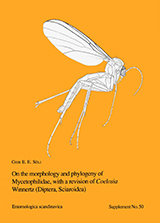Entomologica Scandinavica Supplement 50
now changed to Insect Systematics and Evolution Supplement
ESS 50.
SÖLI, G. E. E. On the morphology and phylogeny of Mycetophilidae, with a revision of Coelosia Winnertz (Diptera, Sciaroidea). 1997. 137 pp. SEK 160.
Abstract:
The world fauna of Coelosia Winnertz, 1863 is revised. Descriptions and diagnoses of the genus and all 24 known species are given, together with keys to males and associated females. A hypothesis of the phylogenetic relationship among the species is presented based on a cladistic analysis. The two genera Boletina and Gnoriste combined were used as outgroup in the analysis. The monophyly of the genus is well supported by the data. Despite much homoplasy, two species groups can be recognised. — All available type material of species assigned to Coelosia have been studied. In addition, identified and unidentified specimens were borrowed from 22 museums and institutions.
All known species are redescribed, and lectotypes designated for bicornis Stackelberg, 1946, flava Staeger, 1840, modesta Johannsen, 1912, sapporoensis Okada, 1939, tenella (Zetterstedt, 1852) and truncata Lundström, 1909. Coelosia fusca Bezzi, 1892 was found to be a senior synonym of silvatica Landrock, 1918, modesta Johannsen, 1912 of quadricornis Stackelberg, 1942, and pygophora Coquillett, 1904 of lepida Johannsen, 1912. Three species are transferred from Coelosia to Coelophthinia Edwards, 1941, namely flavithorax Freemann, 1951, neotropica Lane, 1959 and accita Plassmann & Vogel, 1990.
Thirteen new species are described, burmacola and distylata from the Oriental region, and brevilobata, huitzilopochtlii, longilobata, quetzalcoatli, scopariata, succinacea, tezcatlipocai, tlaloci, vockerothi, xochiquetzali and xolotli from the Nearctic region. — Of the 24 species in the genus, 13 are Nearctic, 6 Palaearctic, 3 Holarctic and 2 Oriental. The northernmost and southernmost records originate from 79°N and 16°N, respectively. Judged from the revealed phylogeny and present distribution of the species, an Eurasian origin of the genus appears most likely. The evolution and diversification of the genus is likely to coincide with the Tertiary palaeogeological development of Eurasia and North America.

